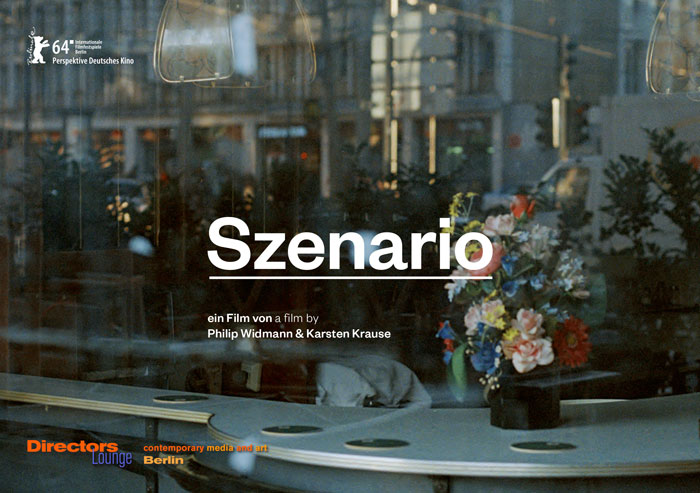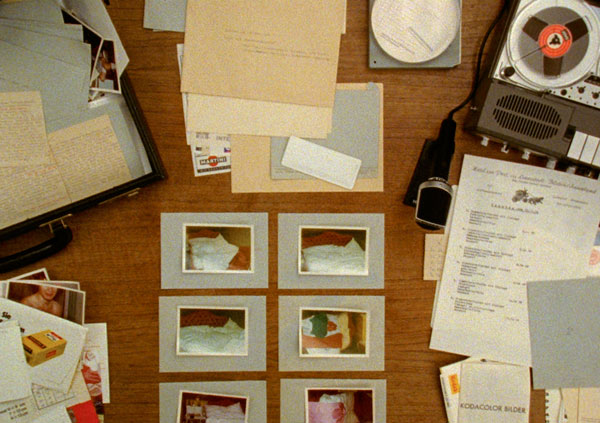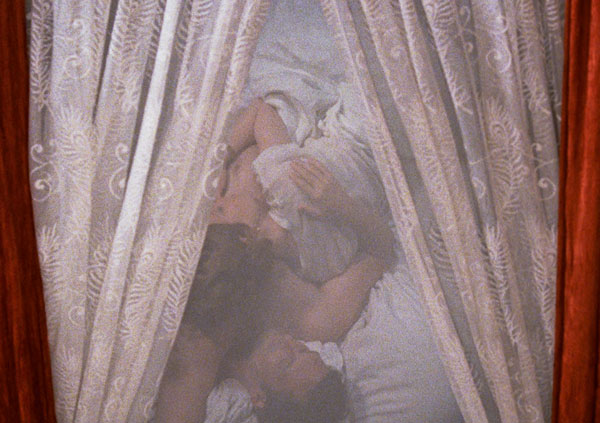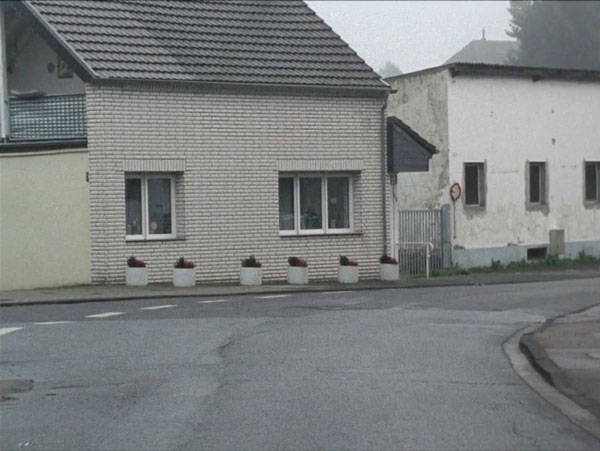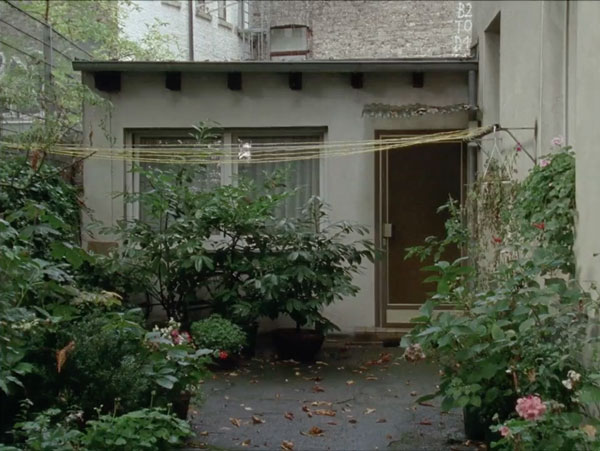 |
directors lounge monthly screenings
philip widmann und karsten krause
Szenario
Donnerstag, 26. Juni 2014
21:00
Z-Bar
Bergstraße 2
10115 Berlin-Mitte
Szenario, die gemeinsame Arbeit der beiden Filmemacher Philip Widman und Karsten Krause, scheint zunächst eine reine Dokumentation einer Liebesaffäre zu sein. Eine Chronik über 3 Monate im Herbst 1970, in der ein verheirateter Mann namens Hans eine Affäre mit seiner Sekretärin namens Monika hat, ebenfalls verheiratet. Die Hauptrolle scheint dabei jedoch der “Koffer" zu sein, eine Kollektion von Notizen, Fotografien, Fahrscheinen und anderen Zetteln aus einem Aktenkoffer, die offenbar von “ihm", dem Liebhaber gesammelt wurden. Die Notizen bestehen vor allem aus getippten Tagebucheinträgen auf Zetteln, auf die Hans minutiös jedes Treffen mit Monika mit Datum und Uhrzeit notierte, wie lange sie miteinander Sex hatten, in welcher Position. Er notierte auch die Orte und unter welchen Umständen sie sich trafen, jedoch immer in der knappen Sprache eines Buchhalters oder Bankangestellten. Die getippten Notizen werden von einer weiblichen Stimme gesprochen, während die Filmbilder Passgen von urbanen Landschaften Kölns zeigen, zumeist als langsame Bewegungsaufnahmen, teilweise von einem Auto aus und sowohl tagsüber als auch nachts.
Was zunächst ganz klar ein Dokumentarfilm zu sein scheint, verändert sich jedoch bei genauerer Betrachtung völlig. Der Film wird zur raffinierten Narration, die den Betrachter immer wieder irritiert, weil sie einerseits zur Immersion des Erzählens verführt und darin frönt. Die Ereignisse werden trotz der trockenen Sprache eigenartig plastisch. Und andererseits spielt er deutlich mit Zweifeln am eigenen Medium: Widersprüche in Ton, Bild und Erzählform. Die Techniken des (Brechtschen) Verfremdens beginnen schon von Anfang an. Es lohnt sich daher, noch einmal eine genauere Lektüre zu unternehmen, beginnend mit den Eröffnungsszenen des Filmes. Eine junge Frau mit großer roter Brille beginnt damit, von einem Script zu
lesen. -*°°*-
Die Frau schaut nach unten, aber wir sehen ihr Skript nicht. Und sie erscheint im ganzen Film nur dieses eine Mal vor der Kamera, in der Eröffnungsszene. Wir erfahren auch nicht ihren Namen. Sie könnte eine Sekretärin sein, aber genauso auch eine Studentin der Geisteswissenschaften. Die Stimme, die wir hören, wird während des Film dieselbe sein, die auch weiterhin Tagebuchnotizen aus dem Off verlesen wird. Der gesprochene Text bzw. die Tagebuchnotizen sprechen davon, wie das Paar miteinander Sex hatte. Jedoch genau als der Text ins Detail über ihre Liebesarten geht, rutschen Bild und Ton aus der Synchronität, um erst am Ende wieder in Sync zusammen zu kommen. Die benutzte Sprache ist geradezu rüde, obwohl er mehrfach betont, dass sie sich sehr liebevoll ihm gegenüber zeigte. Der Blackout mit folgenden Intertitel und Titel des Filmes macht klar, dass wir eben den Trailer sahen. Es bleibt unklar, ob die Frau, die wir gerade sahen dieselbe ist, wie die gehörte Stimme, die aus den Tagebuchnotizen las, oder ob die Frau die wir sahen, eventuell die weibliche Stimme nach-synchronisierte. Es könnte sich auch um zwei unterschiedliche Frauen gehandelt haben. Die im Bild erscheinende Vorleserin bietet also für den weiteren gesprochenen Text eine Art von diegetischer Bild-Sound-Verbindung an, als Erzählerin “seiner Story", dessen wir aber nicht sicher sein können.
In der nun folgenden Eröffnungsszene, nach der Titeleinblendung, zitiert eine männliche Stimme aus Max Frischs “Biographie. Ein Spiel", während die Bildebene eine Panoramaaufnahme vom Wald eines alten Friedhofes abfährt. Der gesprochene Text erzählt von den Komplikationen von Biographien und dem Sinn der Dinge, die hätten passieren können, oder die nicht hätten passieren müssen, und die daher zufällig und eigentlich völlig bedeutungslos sind. Die männliche Stimme spricht ernst, in einer Art neutralem Dokumentarstil. Die Kontinuität der Strassengeräusche, die wir schon in den Friedhofsaufnahmen hörten, erzeugt die Illusion einer Abfolge von Establishing Shots: zunächst Bildschnitt auf eine nächtliche Strassenszene und dann auf die Aussenaufnahme von Galerieräumen. Zur gleichen Zeit beginnt die männliche Stimme einen neuen Abschnitt im Ton, diesmal schildert sie eine Art Setting wie bei einer Theaterszene: Ein Raum, “weiß gestrichene Wände, dunkler Fußboden; ein Stuhl und ein hölzener Tisch..." Als dann ein Ton- und Bildschnitt folgt, der Moment der den Hauptprotagonisten erwarten lässt, erscheint jedoch nur: ein leerer Stuhl, ein Tisch und darauf ein Lederkoffer, und ein altes Uher-Tonbandgerät, das läuft. Wir hören die schon bekannte weibliche Stimme wieder, die die Chronik weiter führt, dieses Mal jedoch mit dem leichten Halleffekt eines kleinen Raumes und damit mit der Illusion des diegetischen Sounds direkt vom Tonband. Die Geschichte, die wir hören ist ein dramatischer Anfang: M. erklärt H., dass seine Frau Rosemarie sich bei ihr zu entschuldigen habe, andererseits würde sie damit aufhören mit ihm zu schlafen. Die Illusion eines authentischen Sounds vom Band ist so stark, dass die weibliche Stimme nun als Erzählstimme fest etabliert ist, vor allem als mit einem Tonschnitt die Erzählung direkter, ohne Halleffekt fortgesetzt wird. Dies bleibt als Eindruck bestehen, obwohl wir erfahren, dass die Erzählstimme nur von den Notizen zitiert und diese gelesene Stimme vom Tonbandgerät aufgezeichnet wird; eigentlich eine doppelte Zitation. Dennoch bleibt sie gefühltermaßen die Erzählstimme in erster Instanz. Es könnte so auch sein, dass sie die personalisierte Stimme des Autors eines Romans ist, der all die Settings enthält, das Tonbandgerät, die erfundenen Bild- und Textnotizen aus dem Koffer und der männliche Schreiber der biografischen Zettel. Zumindest kann es während des Filmes immer wieder passieren, dass der Zuschauer die komplizierte Anordnung vergisst: eigentlich wird ja die weibliche Stimme vom Tonbandgerät abgespielt, dessen Aufzeichnung erfolgt erst durch Ablesen von getippten Zetteln, die aus einem kurioserweise sehr wohlgeordnetem Aktenkoffer stammen. Obwohl wir nur “seinen Part" der Story hören, sind wir doch verführt zu glauben, dass wir die ganze Geschichte erfahren. Zu geläufig sind uns Erzählungen über Frauen aus männlicher Erzählperspektive, die uns glauben machen, dass wir “alles über sie" erfahren. Dennoch, trotz der trockenen Chronik und der rauhbeinigen Sprache die wohl den Jargon von Boulevardblättern zitiert, gewinnt die Geschichte eine unglaubliche Präsenz durch die weibliche Stimme. Manchmal scheint sie geradezu in erster Person zu sprechen, statt zu zitieren. Dagegen erscheint die männliche Stimme als Gegenpart. Sie zitiert Statistiken und Beiträge aus Populärzeitschriften über die durchschnittliche zeitgenössische Frau zu jener Zeit, den frühen 70er Jahren der Bundesrepublik.
Es ist nun für mich wirklich spannend, dass während des Films literarische Werke aus den 70ern in den Sinn kommen. Die pseudodokumentarische Sprache Heinrich Bölls in “Ansichten eines Clowns" und dessen filmische Umsetzung, als auch die tobenden und dennoch chronikartigen Tonbänder des Rolf Dieter Brinkmanns scheinen auf. Möglicherweise ist es auch die Beschreibung der Atmosphäre einer sehr engen BRD-Gesellschaft, die wir hier “in authentischen Dokumenten" vorgestellt bekommen. Jene Werke waren jedoch von der Hoffnung eines großen Umbruchs getragen, besonders auch Brinkmanns Selbstcharakterisierung als Angry Young Man. Die Welt von Monika und Hans (die Namen sind im Film gegenüber dem Original verändert) hat nichts davon. Es ist die enge Welt des Büroalltags , dem die beiden in den kleinen Fluchten zu entkommen suchen, möglich gemacht durch die Pille und durch das anhaltende Wirtschaftswunder. Keine einzige soziale oder politische Anmerkung zu Protesten. Als ich mit Philip Widmann über sein Interesse am Sujet spreche, sagt er mir, dass die 16 Jahre Regierung Helmut Kohls ihn wirklich geprägt haben. Diese Zeit, in der er aufwuchs, hinterliess in ihm einen ähnlichen Eindruck enger, geschlossener Gesellschaft, wie es das gefundene Material zeigt. Und er war interessiert an der Zeit in der seine Mutter jung war. Weiter mag man sich fragen, warum der Zeitgeist der 70er gerade heute wieder aufgegriffen wird. Die Verfilmung der Brinkmann Bänder (Brinkmanns Zorn von Harald Bergmann) kommen als ganz ähnliches Projekt in den Sinn. Das Projekt von Karsten Krause und Philip Widmann bearbeiten das Material allerdings in viel bemerkenswerter Weise. Der Zweifel am Material, an der fast zu geordnet-strukturierten Kollektion, die eventuell schon editiert war, oder womöglich gefälscht, inspirierte die Filmemacher diese in eine Fiktion zu verwandeln, eine Geschichte, die viele Interpretationen und Fragen an die Wahrnehmung des Betrachters zulässt.
Ein weitere Aspekt der halb dokumentarischen, halb fiktiven Geschichte sind die präsentierten filmischen Orte. Obwohl diese in den letzten zwei Jahren aufgenommen wurden, abgesehen von einigen Bildzitaten, sind sie sehr glaubhaft in ihrem Seventies-Feeling. Dies ist umso erstaunlicher, als der Stil der Autos und Kleidung der Passanten zeitgenössische Hinweise enthalten. Die Bilder, Strassenzüge, Büroräume, Treppen und Flure passen voll und ganz in die Zeit der Geschichte des Films. Dass dies gelingt, scheint an der genauen Recherche der Filmemacher zu liegen, die Originalschauplätze in Köln fanden, als auch an der richtigen Farbe, der “passenden" Jahreszeit zwischen September und Dezember, und dem 16mm Filmmaterial mit dem alle Szenen gedreht wurden. Und es liegt natürlich an den hervorragenden Filmaufnahmen. Das Resultat ist ein eigenartig besonderer Film, der eine Menge Fragen aufwirft zur filmischen Wahrnehmung, zu unserer Suche nach Authentizität, zu den Bildern der Vergangenheit den wir uns hingeben, und zu den vorgefassten Bildern die wir durch die Medien verinnerlicht haben.
Artist's Links:
http://www.workscited.de/
Press Links:
Z-Bar - http://www.z-bar.de/
Directors Lounge
 Back Back
|
 |
